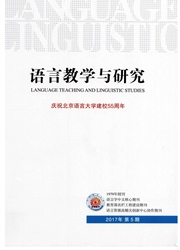

 中文摘要:
中文摘要:
本文首先指出目前“把”字句教学之不足,由此提出从语言信息结构视角重新认识“把”字句的新思路。文章对语言信息结构作了简要介绍,并提出了汉语句子信息结构所遵循的八个准则。接着文章从语言信息结构这一视角分析了表“处置”义的“把”字句,指出从信息传递的角度看,表“处置”义的“把”字句的特点在于:(一)要让“处置者”为话题;(二)要让“处置结果”作为信息聚焦点;(三)运用介词“把”其目的是能自由地将“处置对象”引入句子内,同时表示“处置”的强影响性和说话者的主观认定性,由此凸显“处置结果”。文章最后指出,如果我们能将“把”字句在语言信息结构上与其他句式的差异清楚地告诉外国学生,如果我们能将“把”字句在语言信息传递上的独特性告诉外国学生,这无疑将有助于我们走出“把”字句教学的困境。
 英文摘要:
英文摘要:
Being directed against the shortage of teaching Ba (~)-construction, this pa- per puts forward a new method of re-understanding of the Ba-construction. It firstly provides a brief introduction to the concept of language information structure and presents eight maxims of sentence information structure, and then analyzes a type of Ba-construction denoting "disposal" from a language information structure perspective. It is pointed out that the word Ba denoting "disposal" has the following characteristics: First, it can be used to make "disposer" a topic; second, it makes the"disposal result" an information focus; third, the use of the preposition Ba also helps to introduce the"disposal object" into the sentence, showing the strong influence of "disposal" and the subjective cognition of the speaker, as a result, "disposal result"is highlighted. Finally, it is pointed out that by helping foreign students to clearly distinguish between Ba-construction and other constructions in terms of their different language information structure and the idiosyncrasy of Ba-construction in lan- guage information transfer, we could undoubtedly get out of the plight of Ba-construction teaching.
 同期刊论文项目
同期刊论文项目
 同项目期刊论文
同项目期刊论文
 期刊信息
期刊信息
